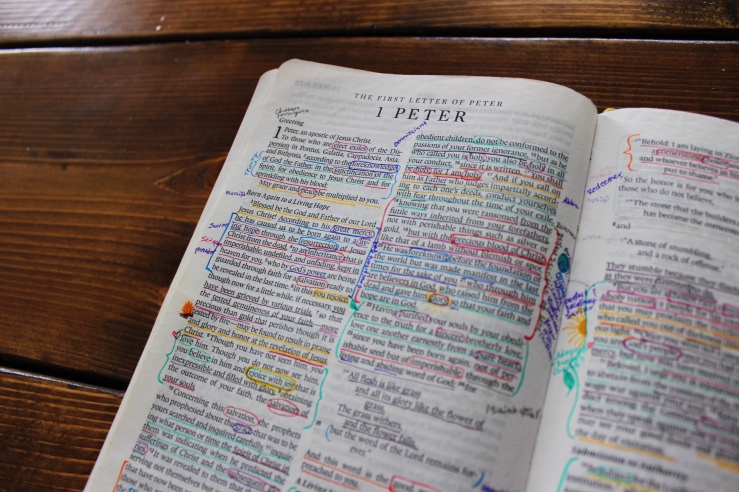
A few years ago I was desperate for some structure in the area of my Bible highlighting. I had a small collection of highlighters, colored pencils, and micron pens that I would use to highlight, underline, and annotate during my daily devotions, but there was very little rhyme or reason to my method of using colors. Finding myself frustrated over and over again at not being able to remember why I had marked a certain verse, caused me to begin forming my own method for color-coding my marking of the Scriptures.
What I did understand about my old method of hodgepodge colors and markings was that each new color communicated a different thought or meaning. The problem lay in that there was no guide for what each color meant, so I would use whatever writing utensil was closest to reach.
In my mid-teens I finally developed a method of color-coding that worked with my brain, helping me to better study the Word of God.

Taking the wordless bracelet color scheme as inspiration and a loose guide, I connected different colors with different Biblical themes and topics, in a way that made sense to my visual learning. I took colors that I associated with certain earthly things or ideas, such as green for science and growth, purple for royalty and riches, blue for the endless sky, and so on, and related them to how I would best view them when studying the Bible.
I ended up with this:
Red: Jesus Christ & Themes of Redemption
Orange: God’s Blessings, Promises, & Commands
Yellow: Prayer, Praises, & Laments
Green: Christian Growth & Living
Blue: God’s Sovereignty & Actions
Purple: God’s Character & Attributes
Pink: Holiness (things set apart), Purity, & Goodness
Brown: Sin, Evil, and Satan
Black: Random Notes, Prayers, Connections, Observations, & Other Miscellaneous

Now I can open up to any page of my Bible and understand what I wanted to make note of with my highlighting, as well as flip through the pages to find texts related to certain themes. Not only has this method helped me with my organization, but it has helped teach me how to really read and observe biblical text, not just skim and jump straight to practical application to my own life. I must first spend enough time reading the text to know how I should mark it, and see what it has to say about the Lord, before I go on to application.
This method has also helped me to become more prayerful during my Bible study and devotions, having to take the time to sit in the Word of God, seeing how the Lord moved in the lives of the biblical characters, and reading the prayers of the People of God. I often write little prayers in the margin, or underline in yellow, so when I go through passages later, I see the faithfulness of God in my life and other’s.

Now that I have used this method for a few years now, the colors and connections are memorized, and it has become much easier to know how to apply it to the text. It was rough going at first, but with some practice it has become a bit like second nature to know what colored pen to reach for.

This color-coding method may not click as easily for some people as it did with my brain, but it could easily be revised or adjusted to make sense for others.
Whatever method you find helpful for you, may it help you to grow in your love for the Scriptures and the Lord.

Love this! Thanks for sharing!!
LikeLike
Hi Emma, thanks for sharing this I really enjoy a well marked Bible and do the same with mine. I really like the color scheme. Do you find that when you have that much marked up instead of selecting certain verses to mark up that it’s a little bit harder to read the text or does this help you see connections better?
LikeLiked by 1 person
The colors don’t seem to crowd it too much, and for me personally, it helps me follow the flow of the text. 🙂
LikeLike